马尔可夫链的基本概念
随机过程(Stochastic Process)
什么是随机过程
- 随机过程就是一组按“时间/索引”排列的随机变量 $\{X_t: t\in \mathcal{T}\}$。
- $\mathcal{T}$ 是索引集合:可以是离散的($t=0,1,2,\dots$)也可以是连续的($t\in \mathbb{R}_{\ge 0}$)。
- 每个 $X_t$ 取值于一个状态空间 $\mathcal{S}$(可离散/连续)。
离散时间 vs 连续时间
- 离散时间(DT):$t=0,1,2,\dots$。本节主要讲离散时间马尔可夫链(DTMC)。
- 连续时间(CT):$t\in\mathbb{R}_{\ge 0}$,对应连续时间马尔可夫链(CTMC),用生成元而非转移矩阵描述。
马尔可夫性质(Markov Property)
无记忆性:下一步只取决于当前,不取决于更久远的历史。
离散时间、齐次马尔可夫链(时间不变)定义为:
$$ \mathbb{P}(X_{t+1}=j \mid X_t=i, X_{t-1},\dots,X_0)=\mathbb{P}(X_{t+1}=j\mid X_t=i)=p_{ij}, $$其中 $p_{ij}$ 与 $t$ 无关(齐次)。如果允许随时间变化,就是非齐次马尔可夫链。
推论(Chapman–Kolmogorov):多步转移概率满足
$$ P^{(n+m)} = P^{(n)}P^{(m)}, $$特别地,$n$ 步转移矩阵 $P^{(n)}=P^n$。
转移概率矩阵(Transition Matrix)
定义与性质
对于有限状态空间 $\mathcal{S}=\{1,\dots, S\}$,定义转移矩阵 $P=[p_{ij}]_{S\times S}$,其中
$$ p_{ij}=\mathbb{P}(X_{t+1}=j\mid X_t=i). $$行随机(row-stochastic):每一行是一组概率
$$ p_{ij}\ge 0,\quad \sum_{j=1}^S p_{ij}=1\quad(\forall i). $$记分布向量为行向量 $\pi_t=[\mathbb{P}(X_t=1),\dots,\mathbb{P}(X_t=S)]$,则
$$ \pi_{t+1}=\pi_t P,\quad \pi_t=\pi_0 P^t. $$
示例
import numpy as np
import matplotlib.pyplot as plt
# ============ 基础工具 ============
def is_row_stochastic(P, tol=1e-12):
"""检查转移矩阵是否“行随机”(每行和约为1,元素>=0)"""
P = np.asarray(P, dtype=float)
nonneg = np.all(P >= -tol) # 检查非负性
rowsum_one = np.allclose(P.sum(axis=1), 1.0, atol=1e-10) # 检查每行和是否约为1
return bool(nonneg and rowsum_one), P.sum(axis=1)
def n_step_transition(P, n):
"""n 步转移矩阵:P^n"""
return np.linalg.matrix_power(np.asarray(P, dtype=float), n)
def simulate_markov_chain(P, init_state, n_steps, rng=None):
"""
从单个初始状态模拟一条马尔可夫链路径。
P: 行随机矩阵;init_state: int (0..S-1);返回数组 shape=(n_steps+1,)
"""
if rng is None:
rng = np.random.default_rng()
P = np.asarray(P, dtype=float)
S = P.shape[0] # 状态数
path = np.empty(n_steps+1, dtype=int) # 初始化路径
path[0] = int(init_state) # 确保初始状态是整数
for t in range(n_steps): # 逐步生成路径
i = path[t]
path[t+1] = rng.choice(S, p=P[i]) # 从当前状态 i 选择下一个状态
return path
def simulate_many(P, pi0, n_steps, n_runs=10000, rng=None):
"""
模拟多条路径,估计各时刻的经验分布(与理论 pi0 P^t 对比)。
返回:
emp_dist: shape=(n_steps+1, S) 经验分布
th_dist : shape=(n_steps+1, S) 理论分布
"""
if rng is None:
rng = np.random.default_rng()
P = np.asarray(P, dtype=float)
S = P.shape[0]
# 理论分布随时间演化
th = np.zeros((n_steps+1, S))
th[0] = pi0
for t in range(n_steps):
th[t+1] = th[t] @ P
# 经验分布
counts = np.zeros((n_steps+1, S), dtype=int)
init_states = rng.choice(S, size=n_runs, p=pi0)
for r in range(n_runs):
s0 = init_states[r]
path = simulate_markov_chain(P, s0, n_steps, rng=rng)
for t in range(n_steps+1):
counts[t, path[t]] += 1
emp = counts / n_runs
return emp, th
示例 1:两状态(天气示例:晴=S,雨=R)
模型设定(两状态天气链)
状态:0=晴 (Sunny),1=雨 (Rainy) 转移矩阵:
$$ P=\begin{bmatrix} \text{晴→晴} & \text{晴→雨}\\ \text{雨→晴} & \text{雨→雨} \end{bmatrix}=\begin{bmatrix} 0.8 & 0.2\\ 0.4 & 0.6 \end{bmatrix} $$含义:晴→晴 0.8、晴→雨 0.2;雨→晴 0.4、雨→雨 0.6。
- 行随机:每行和为 1(合法概率矩阵)。
- 不可约:每个状态都能到达另一个状态(两行都含非零对向转移)。
- 非周期:对角元 $p_{00},p_{11}>0$(有自环),周期为 1。 ⇒ 链是遍历的(ergodic):存在唯一平稳分布,且从任意初值都会收敛到它。
# ============ 示例 1:两状态(晴/雨) ============
# 状态编码:0=晴(S), 1=雨(R)
P2 = np.array([[0.8, 0.2],
[0.4, 0.6]], dtype=float)
ok, rowsums = is_row_stochastic(P2)
print("P2 行随机性检查:", ok, " 行和=", rowsums)
# 单一路径模拟与可视化
rng = np.random.default_rng(2025)
path = simulate_markov_chain(P2, init_state=0, n_steps=50, rng=rng)
plt.figure(figsize=(9,3))
plt.plot(range(len(path)), path, marker='o')
plt.hlines(0, -1, len(path)-1, colors='green', linestyles='dashed', label="Sunny")
plt.hlines(1, -1, len(path)-1, colors='yellow', linestyles='dashed', label="Rainy")
plt.text(10, -0.4, "样本路径(状态随时间跳变的折线)", fontsize=12, color='red')
plt.title("Sample path of 2-state Markov chain (0=Sunny, 1=Rainy)")
plt.xlabel("time t")
plt.ylabel("state")
plt.legend()
plt.show()
# 多路径统计 vs 理论分布
pi0 = np.array([0.5, 0.5]) # 初始分布
emp, th = simulate_many(P2, pi0, n_steps=20, n_runs=5000, rng=rng)
# 画“处于 Sunny 的概率”随时间变化:理论 vs 经验
plt.figure(figsize=(9,4))
plt.plot(th[:,0], label="theory P(X_t=Sunny)")
plt.plot(emp[:,0], label="empirical P(X_t=Sunny)")
plt.text(3, 0.6, "理论分布与模拟经验分布几乎重合(随样本数增大吻合更好)。", fontsize=12, color='red')
plt.title("Distribution evolution in 2-state chain")
plt.xlabel("time t")
plt.ylabel("probability of Sunny")
plt.legend()
plt.show()
# n 步转移矩阵示例
P2_5 = n_step_transition(P2, 5)
print("P2^5 =\n", np.round(P2_5, 4))
P2 行随机性检查: True 行和= [1. 1.]
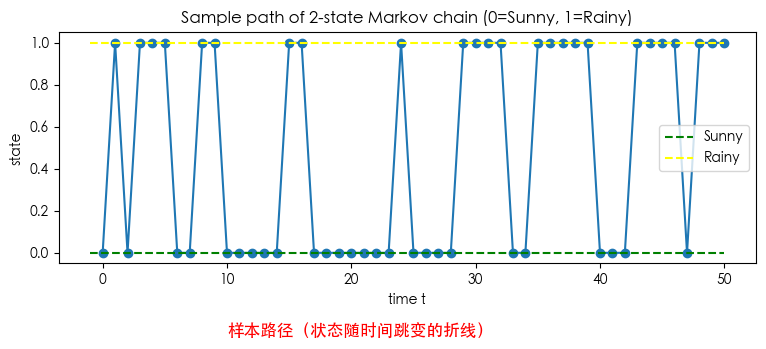
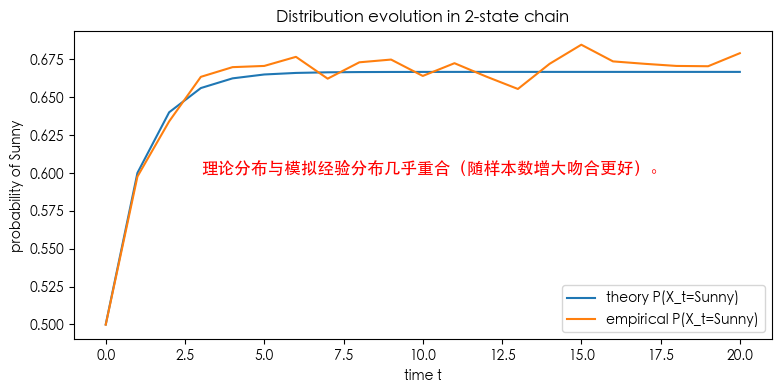
P2^5 =
[[0.6701 0.3299]
[0.6598 0.3402]]
示例 2:三状态(含吸收态 C)
$$ P_3= \begin{bmatrix} 0.6 & 0.4 & 0.0\\ 0.2 & 0.5 & 0.3\\ 0.0 & 0.0 & 1.0 \end{bmatrix}, $$# ============ 示例 2:三状态(含吸收态 C) ============
# 状态编码:0=A, 1=B, 2=C(吸收)
P3 = np.array([[0.6, 0.4, 0.0],
[0.2, 0.5, 0.3],
[0.0, 0.0, 1.0]], dtype=float)
ok3, rowsums3 = is_row_stochastic(P3)
print("P3 行随机性检查:", ok3, " 行和=", rowsums3)
path3 = simulate_markov_chain(P3, init_state=0, n_steps=40, rng=rng)
plt.figure(figsize=(9,3))
plt.plot(range(len(path3)), path3, marker='o')
plt.text(10, 1.5, "样本路径(状态随时间跳变的折线)\n状态 C 一旦进入就不离开(吸收态)。", fontsize=12, color='red')
plt.title("Sample path of 3-state chain (2 is absorbing)")
plt.xlabel("time t")
plt.ylabel("state (0=A, 1=B, 2=C)")
plt.show()
# 多路径统计:观测吸收到 C 的概率随时间变化
pi0_3 = np.array([1.0, 0.0, 0.0]) # 从 A 起步
emp3, th3 = simulate_many(P3, pi0_3, n_steps=20, n_runs=5000, rng=rng)
plt.figure(figsize=(9,4))
plt.plot(th3[:,2], label="theory P(X_t=C)")
plt.plot(emp3[:,2], label="empirical P(X_t=C)")
plt.text(5, 0.2, "理论分布与模拟经验分布几乎重合(随样本数增大吻合更好)。\n吸收态 C 的概率随时间单调上升", fontsize=12, color='red')
plt.title("Absorption probability into state C over time")
plt.xlabel("time t")
plt.ylabel("probability in C")
plt.legend()
plt.show()
# n 步转移矩阵示例
P3_5 = n_step_transition(P3, 5)
print("P3^5 =\n", np.round(P3_5, 4))
P3 行随机性检查: True 行和= [1. 1. 1.]
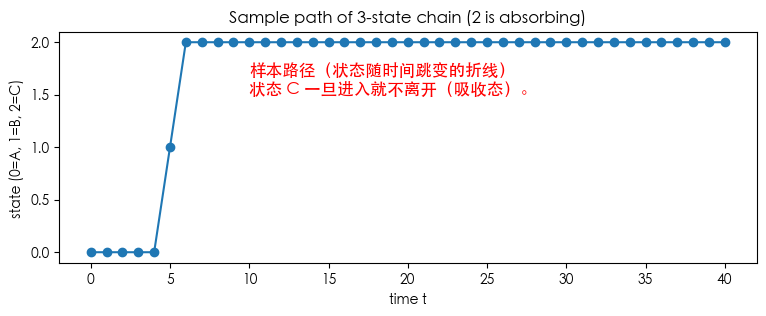
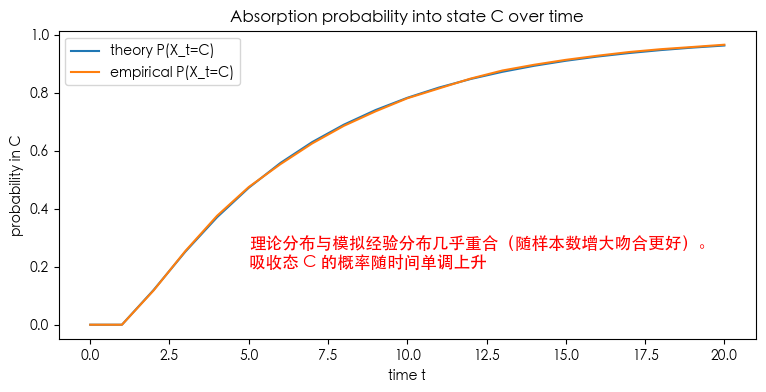
P3^5 =
[[0.242 0.2856 0.4724]
[0.1428 0.1706 0.6866]
[0. 0. 1. ]]
小结
- 随机过程:按时间索引的一族随机变量。
- 离散/连续时间:本节以离散时间链为主。
- 马尔可夫性质:下一步只依赖当前;齐次链的转移概率与时间无关。
- 转移矩阵:行随机矩阵;多步转移用幂 $P^n$;分布随时间演化 $\pi_t=\pi_0 P^t$。
- 例子:两状态(天气)、三状态(含吸收态)展示了基本计算与模拟。
马尔可夫链的长期行为和收敛性
平稳分布 (Stationary Distribution)
定义:一个概率向量 $\pi$,如果
$$ \pi P = \pi, \quad \sum_i \pi_i = 1, \; \pi_i \geq 0 $$那么 $\pi$ 称为该马尔可夫链的 平稳分布。
意义:如果链在某个时刻的分布是 $\pi$,那么在之后任意时刻仍然保持 $\pi$。它描述了 长期状态分布。
状态分类
可达性 (Reachability):状态 $i \to j$ 如果存在某个 $n$,使得 $(P^n)_{ij} > 0$。
常返/暂留:
- 常返 (Recurrent):从 $i$ 出发,最终必然返回 $i$。
- 暂留 (Transient):有非零概率永远不返回。
不可约 (Irreducible):所有状态两两可达 → 链是一个整体。
周期性 (Periodicity):
- 状态 $i$ 的周期:$\gcd\{ n : (P^n)_{ii} > 0 \}$。
- 若周期 = 1,则为 非周期 (aperiodic)。
遍历定理 (Ergodic Theorem)
定理: 对一个有限马尔可夫链,如果它是 不可约 且 非周期,则存在唯一平稳分布 $\pi$,并且:
$$ \lim_{n \to \infty} P(X_n = j \mid X_0 = i) = \pi_j \quad \forall i,j $$同时,时间平均收敛到概率平均:
$$ \frac{1}{N}\sum_{t=1}^N \mathbf{1}_{\{X_t=j\}} \to \pi_j $$
混合时间 (Mixing Time)
收敛速度的度量
定义:链从初始分布 $\mu$ 到接近平稳分布所需的时间。
常用距离:全变差距离 (total variation distance)
$$ d(t) = \max_\mu \| \mu P^t - \pi \|_{TV} $$混合时间:最小 $t$,使得 $d(t) \leq \epsilon$。
示例
示例 1:两状态马尔可夫链
最简单的演示,清晰看到收敛到平稳分布。
转移矩阵:
$$ P = \begin{bmatrix} 0.9 & 0.1 \\ 0.5 & 0.5 \end{bmatrix} $$(a) 平稳分布
解方程:
$$ \pi P = \pi $$即:
$$ \pi_0 = 0.9\pi_0 + 0.5\pi_1 \quad\Rightarrow\quad 0.1\pi_0 = 0.5\pi_1 $$结合 $\pi_0 + \pi_1 = 1$,解得:
$$ \pi = (0.833..., \; 0.166...) $$(b) 性质分析
- 不可约。因为两个状态互相可达(两行都含非零对向转移)。
- 非周期:因为 $P_{00}>0, P_{11}>0$(有自环),可保持在原状态 → 周期 = 1
综上,根据遍历定理,该有限马尔可夫链是遍历的(ergodic),即存在唯一平稳分布,且从任意初值都会收敛到它。
(c) 收敛过程
import numpy as np
import matplotlib.pyplot as plt
P = np.array([[0.9, 0.1],
[0.5, 0.5]])
# 初始分布
mu = np.array([1.0, 0.0])
distributions = [mu]
for _ in range(20):
mu = mu @ P
distributions.append(mu)
distributions = np.array(distributions)
plt.plot(distributions[:,0], label="Pr[state=0]")
plt.plot(distributions[:,1], label="Pr[state=1]")
plt.axhline(0.833, color="gray", linestyle="--", label="π0")
plt.axhline(0.167, color="gray", linestyle="--", label="π1")
plt.text(2.5, 0.7, "从状态 0 出发,概率分布逐步收敛到 (0.833, 0.167)", fontsize=12, color='red')
plt.xlabel("Step")
plt.ylabel("Probability")
plt.legend()
plt.title("Convergence to Stationary Distribution")
plt.show()
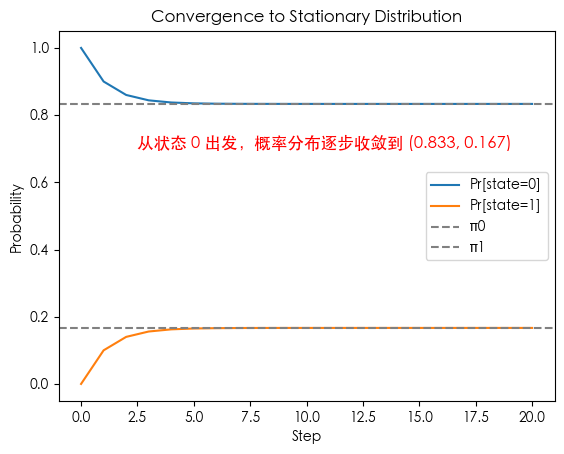
示例 2:三状态马尔可夫链
展示了更复杂链中平稳分布的存在性和唯一性。
转移矩阵:
$$ P = \begin{bmatrix} 0.5 & 0.5 & 0.0 \\ 0.2 & 0.5 & 0.3 \\ 0.0 & 0.3 & 0.7 \end{bmatrix} $$- 不可约:所有状态可互相到达。
- 非周期:存在自循环概率 $P_{ii} > 0$。
- 平稳分布:解 $\pi P = \pi$,得到唯一 $\pi$。
- 长期行为:所有初始分布都会收敛到 $\pi$。
import numpy as np
import matplotlib.pyplot as plt
# 三状态马尔可夫链转移矩阵
P = np.array([[0.5, 0.5, 0.0],
[0.2, 0.5, 0.3],
[0.0, 0.3, 0.7]])
# 初始分布(全部在状态0)
mu = np.array([1.0, 0.0, 0.0])
# 计算平稳分布:解 pi P = pi
eigvals, eigvecs = np.linalg.eig(P.T)
stat_dist = eigvecs[:, np.isclose(eigvals, 1)]
stat_dist = stat_dist[:,0]
stat_dist = stat_dist / stat_dist.sum() # 归一化
print("Stationary distribution:", stat_dist.real)
# 迭代分布演化
distributions = [mu]
for _ in range(30):
mu = mu @ P
distributions.append(mu)
distributions = np.array(distributions)
# 绘图
plt.figure(figsize=(8,5))
for i in range(3):
plt.plot(distributions[:, i], label=f"Pr[state={i}]")
plt.axhline(stat_dist[i].real, linestyle="--", color="gray")
plt.text(5, 0.8, "从初始状态全在 0 出发,\n随着步数增加,概率分布逐渐收敛到这组平稳分布;\n横虚线表示平稳分布值。", fontsize=12, color='red')
plt.xlabel("Step")
plt.ylabel("Probability")
plt.title("Convergence of 3-State Markov Chain")
plt.legend()
plt.show()
Stationary distribution: [0.16666667 0.41666667 0.41666667]
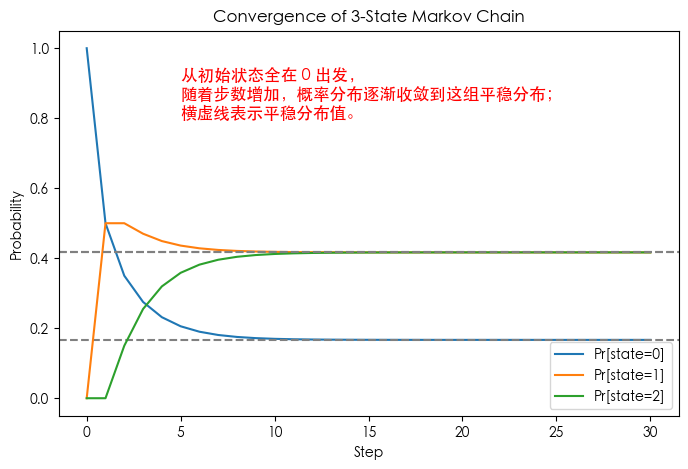
示例 3:环形随机游走 (Random Walk on a Cycle)
展示了 周期性 对收敛性的影响。
状态:$\{0,1,2,\dots,n-1\}$。
转移规则:从当前位置 $i$,以概率 0.5 移动到 $(i−1)\bmod n$,以概率 0.5 移动到 $(i+1)\bmod n$。即
$$ P(i \to i+1 \bmod n) = 0.5, \quad P(i \to i-1 \bmod n) = 0.5 $$不可约:从任意状态可到任意状态。
周期性:如果 $n$ 是偶数,则周期 = 2;如果 $n$ 是奇数,则非周期。
平稳分布:均匀分布 $\pi_i = 1/n$。
收敛性:
- 若 $n$ 奇数 → 链是不可约且非周期 → 收敛到均匀分布。
- 若 $n$ 偶数 → 链有周期性(周期=2) → 链会在“奇数/偶数类”之间来回跳,无法收敛到均匀分布。
import numpy as np
import matplotlib.pyplot as plt
def ring_rw_transition_matrix(n):
"""生成 n 状态的环形随机游走转移矩阵"""
P = np.zeros((n, n))
for i in range(n):
P[i, (i-1)%n] = 0.5
P[i, (i+1)%n] = 0.5
return P
def simulate_chain(P, steps=30, start_state=0):
"""从单点分布开始,计算分布演化"""
n = P.shape[0]
mu = np.zeros(n)
mu[start_state] = 1.0
distributions = [mu]
for _ in range(steps):
mu = mu @ P
distributions.append(mu)
return np.array(distributions)
# 参数
steps = 30
P5 = ring_rw_transition_matrix(5)
P6 = ring_rw_transition_matrix(6)
# 模拟
dist5 = simulate_chain(P5, steps)
dist6 = simulate_chain(P6, steps)
# 平稳分布(对于奇数 n,均匀分布;偶数情况不存在唯一收敛)
pi5 = np.ones(5) / 5
pi6 = np.ones(6) / 6
# 绘图
fig, axes = plt.subplots(2, 1, figsize=(8,8), sharex=True)
# n=5
for i in range(5):
axes[0].plot(dist5[:, i], label=f"state {i}")
axes[0].hlines(pi5, 0, steps, colors="gray", linestyles="--", linewidth=1)
axes[0].set_title("Ring Random Walk (n=5, odd → converges to uniform)")
axes[0].set_ylabel("Probability")
axes[0].legend()
# n=6
for i in range(6):
axes[1].plot(dist6[:, i], label=f"state {i}")
axes[1].hlines(pi6, 0, steps, colors="gray", linestyles="--", linewidth=1)
axes[1].set_title("Ring Random Walk (n=6, even → oscillates)")
axes[1].set_xlabel("Step")
axes[1].set_ylabel("Probability")
axes[1].legend()
plt.tight_layout()
plt.show()
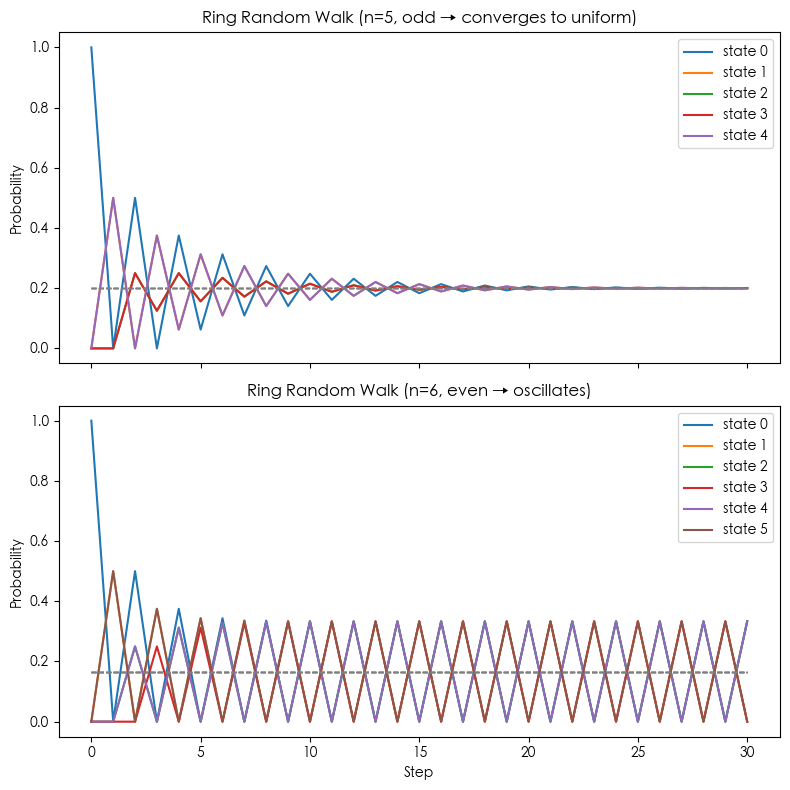
示例 4: 混合时间 (Mixing Time) 的数值度量(比如 total variation distance 收敛速度)
# Simulate Markov chains and compute total variation distance (TV) to the stationary distribution.
# We will:
# 1. Define several transition matrices (fast/slow 3-state, cycle random walks n=5 and n=6).
# 2. Compute TV distance over time starting from state 0.
# 3. Compute mixing times tau(epsilon) for epsilons = [0.1, 0.01, 0.001].
# 4. Plot TV vs time for comparisons and show a table of mixing times.
#
# Note: Plots use matplotlib (no seaborn) and each figure is a single plot as requested.
import numpy as np
import pandas as pd
import matplotlib.pyplot as plt
def stationary_from_P(P):
# solve pi = pi P with sum(pi)=1 -> transpose eigenvector of P^T for eigenvalue 1
w, v = np.linalg.eig(P.T)
idx = np.argmin(np.abs(w - 1.0))
pi = np.real(v[:, idx])
pi = pi / pi.sum()
pi = np.maximum(pi, 0)
pi = pi / pi.sum()
return pi
def tv_distance(p, q):
return 0.5 * np.sum(np.abs(p - q))
def tv_curve(P, p0, t_max):
n = P.shape[0]
pis = stationary_from_P(P)
p = p0.copy()
tvs = []
for t in range(t_max + 1):
tvs.append(tv_distance(p, pis))
p = p @ P
return np.array(tvs), pis
def mixing_time_from_tvs(tvs, eps):
# minimal t such that tvs[t] <= eps
below = np.where(tvs <= eps)[0]
return int(below[0]) if below.size > 0 else np.nan
# Define chains
# 3-state fast chain
P_fast = np.array([
[0.6, 0.3, 0.1],
[0.2, 0.6, 0.2],
[0.1, 0.3, 0.6]
])
# 3-state slow chain (more "sticky" on state 0)
P_slow = np.array([
[0.9, 0.08, 0.02],
[0.2, 0.7, 0.1],
[0.15, 0.15, 0.7]
])
# Cycle random walk
def cycle_P(n):
P = np.zeros((n, n))
for i in range(n):
P[i, (i+1) % n] = 0.5
P[i, (i-1) % n] = 0.5
return P
P_cycle5 = cycle_P(5)
P_cycle6 = cycle_P(6)
# initial distribution: start at state 0
def e0(n):
v = np.zeros(n); v[0]=1.0; return v
t_max = 200
# compute tv curves
tvs_fast, pi_fast = tv_curve(P_fast, e0(3), t_max)
tvs_slow, pi_slow = tv_curve(P_slow, e0(3), t_max)
tvs_c5, pi_c5 = tv_curve(P_cycle5, e0(5), t_max)
tvs_c6, pi_c6 = tv_curve(P_cycle6, e0(6), t_max)
# compute mixing times for selected epsilons
epsilons = [1e-1, 1e-2, 1e-3]
rows = []
for name, tvs in [
("3-state fast", tvs_fast),
("3-state slow", tvs_slow),
("cycle n=5", tvs_c5),
("cycle n=6", tvs_c6)
]:
entry = {"chain": name}
for eps in epsilons:
entry[f"tau({eps})"] = mixing_time_from_tvs(tvs, eps)
rows.append(entry)
df_mix = pd.DataFrame(rows)
# Plot 1: 3-state fast vs slow
plt.figure(figsize=(8,4))
plt.plot(tvs_fast, label='3-state fast')
plt.plot(tvs_slow, label='3-state slow')
plt.yscale('log') # show both fast and slow clearly on log scale
plt.xlabel('time t')
plt.ylabel('TV distance (log scale)')
plt.title('Total Variation distance: 3-state fast vs slow (start at state 0)')
plt.legend()
plt.grid(True)
plt.tight_layout()
plt.show()
# Plot 2: cycle n=5 vs n=6
plt.figure(figsize=(8,4))
plt.plot(tvs_c5, label='cycle n=5')
plt.plot(tvs_c6, label='cycle n=6')
plt.yscale('log')
plt.xlabel('time t')
plt.ylabel('TV distance (log scale)')
plt.title('Total Variation distance: cycle random walk n=5 vs n=6 (start at state 0)')
plt.legend()
plt.grid(True)
plt.tight_layout()
plt.show()
# Also print stationary distributions for reference
pi_table = pd.DataFrame({
"chain": ["3-state fast", "3-state slow", "cycle n=5", "cycle n=6"],
"stationary": [pi_fast, pi_slow, pi_c5, pi_c6]
})
pi_table['stationary_str'] = pi_table['stationary'].apply(lambda x: np.array2string(x, precision=4, separator=', '))
pi_table = pi_table[['chain','stationary_str']]
display("Stationary distributions", pi_table)
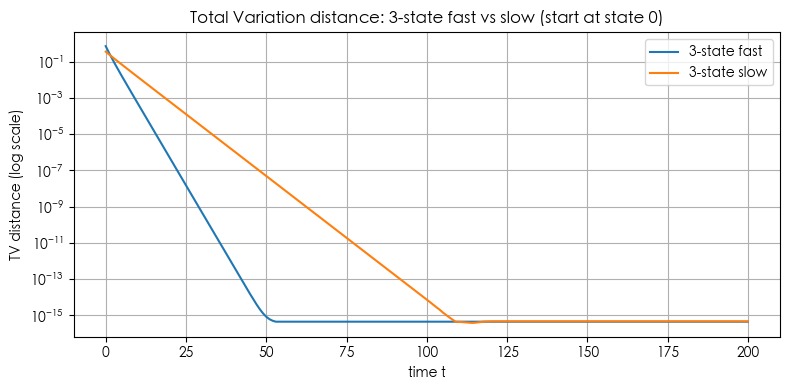
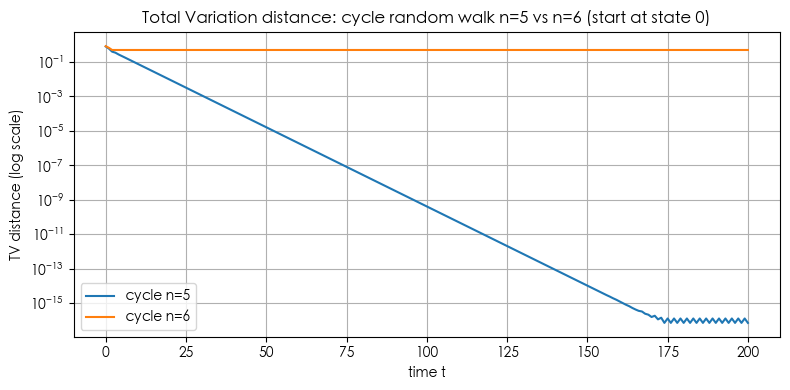
'Stationary distributions'
| chain | stationary_str | |
|---|---|---|
| 0 | 3-state fast | [0.2857, 0.4286, 0.2857] |
| 1 | 3-state slow | [0.6466, 0.2328, 0.1207] |
| 2 | cycle n=5 | [0.2, 0.2, 0.2, 0.2, 0.2] |
| 3 | cycle n=6 | [0.1667, 0.1667, 0.1667, 0.1667, 0.1667, 0.1667] |